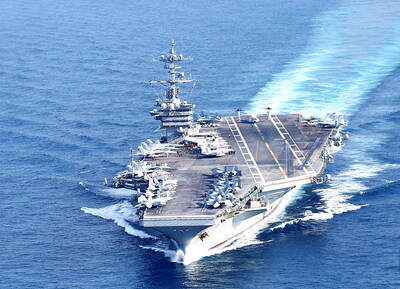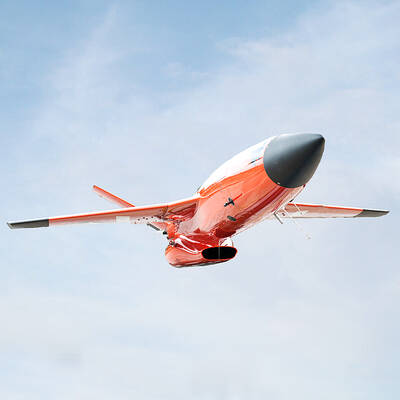The Ministry of National Defense’s annual National Defense Report, released yesterday, outlines the capability of domestic weapons, Taiwan’s increasing role in regional security and strategies for countering the continual threat of China’s military.
The main theme of the report is the military as a “defender of peace,” as it joins with Australia, Japan, South Korea, the Philippines, Singapore and Thailand in promoting the US’ Indo-Pacific strategy.
The nation’s indigenous defense industry has greatly evolved since President Tsai Ing-wen (蔡英文) took office, ministry spokesman Shih Shun-wen (史順文) told a news conference in Taipei.
The industry’s advancement has sustained existing projects and initiated new programs, including the manufacture of precision-fire missiles, unmanned aerial vehicles (UAVs), armored personnel carriers, Tuo Jiang-class guided-missile corvettes and submarines, the report said.
“The main military threat still comes from China, as its top leaders have not renounced the use of force to invade Taiwan, have spent a substantial portion of the national budget on increasing its military strength and moved to quickly modernize its armed forces. By trying to unilaterally alter the status quo across the Taiwan Strait, China poses the most serious challenge for Taiwan’s national security,” the report quoted Defense Policy Division Director Teng Keh-syong (鄧克雄) as saying.
Included in the report is a map showing the expanded range of China’s Dongfeng ballistic missiles. The earlier version could already reach Taiwan and most of Southeast Asia with its range of 1,000km.
The upgraded Dongfeng 10 and 21 has a range of 1,600km and can reach all of Japan, much of India and the Asia-Pacific region’s “second island chain.”
The ministry has a new telecommunications unit to combat fake news and misinformation regarding the military, Teng said, adding that through QR codes and the ministry’s Web sites, the unit can engage with the public and the media to rapidly correct false information.
The report was released with a summarized, comic book version that targets the younger generation so that the public can understand the nation’s defense programs and military strategies.
For the first time, the report presents new coastal defense plans to repel a force invading across the Taiwan Strait.
Previously, the military saw beaches as the focal point for repelling a potential invasion, but in 2017 that strategy was revised to include a broader perimeter, the report says.
Taiwan has been forced to shift its strategy as China has been developing expeditionary warfare and over-the-horizon amphibious assault capabilities that pose a threat all along Taiwan’s coastline, Teng said.
The report contains an illustration of how the military would repel an invasion of naval and aerial units, targeting a landing site along Taiwan’s coast.
It shows the nation’s larger warships and naval vessels being deployed along a perimeter in coastal areas as a first line of defense against possible invaders.
Behind those vessels, naval mines are used as a second line of defense, followed by Tuo Jiang-class corvettes and smaller naval vessels, while armored vehicles, tanks, multiple rocket launchers and other weapons systems are deployed on beaches.
It shows precision-fire missiles and military aircraft being used as further deterrence — all as part of the military’s “multiple deterrence” strategy adopted in 2017.
Additional reporting by CNA

CROSS-STRAIT COLLABORATION: The new KMT chairwoman expressed interest in meeting the Chinese president from the start, but she’ll have to pay to get in Beijing allegedly agreed to let Chinese Nationalist Party (KMT) Chairwoman Cheng Li-wun (鄭麗文) meet with Chinese President Xi Jinping (習近平) around the Lunar New Year holiday next year on three conditions, including that the KMT block Taiwan’s arms purchases, a source said yesterday. Cheng has expressed interest in meeting Xi since she won the KMT’s chairmanship election in October. A source, speaking on condition of anonymity, said a consensus on a meeting was allegedly reached after two KMT vice chairmen visited China’s Taiwan Affairs Office Director Song Tao (宋濤) in China last month. Beijing allegedly gave the KMT three conditions it had to

STAYING ALERT: China this week deployed its largest maritime show of force to date in the region, prompting concern in Taipei and Tokyo, which Beijing has brushed off Deterring conflict over Taiwan is a priority, the White House said in its National Security Strategy published yesterday, which also called on Japan and South Korea to increase their defense spending to help protect the first island chain. Taiwan is strategically positioned between Northeast and Southeast Asia, and provides direct access to the second island chain, with one-third of global shipping passing through the South China Sea, the report said. Given the implications for the US economy, along with Taiwan’s dominance in semiconductors, “deterring a conflict over Taiwan, ideally by preserving military overmatch, is a priority,” it said. However, the strategy also reiterated

‘BALANCE OF POWER’: Hegseth said that the US did not want to ‘strangle’ China, but to ensure that none of Washington’s allies would be vulnerable to military aggression Washington has no intention of changing the “status quo” in the Taiwan Strait, US Secretary of Defense Pete Hegseth said on Saturday, adding that one of the US military’s main priorities is to deter China “through strength, not through confrontation.” Speaking at the annual Reagan National Defense Forum in Simi Valley, California, Hegseth outlined the US Department of Defense’s priorities under US President Donald Trump. “First, defending the US homeland and our hemisphere. Second, deterring China through strength, not confrontation. Third, increased burden sharing for us, allies and partners. And fourth, supercharging the US defense industrial base,” he said. US-China relations under

The Chien Feng IV (勁蜂, Mighty Hornet) loitering munition is on track to enter flight tests next month in connection with potential adoption by Taiwanese and US armed forces, a government source said yesterday. The kamikaze drone, which boasts a range of 1,000km, debuted at the Taipei Aerospace and Defense Technology Exhibition in September, the official said on condition of anonymity. The Chungshan Institute of Science and Technology and US-based Kratos Defense jointly developed the platform by leveraging the engine and airframe of the latter’s MQM-178 Firejet target drone, they said. The uncrewed aerial vehicle is designed to utilize an artificial intelligence computer